Abstract
The Sun (Sūrya) occupies a foundational place in Vedic thought, revered simultaneously as a cosmic deity, a temporal regulator, and the sustainer of life. This article examines solar depictions in Vedic and post-Vedic literature through the lens of modern science- integrating insights from astronomy, astrophysics, chronobiology, and environmental science. The analysis reveals profound observational accuracy and symbolic sophistication, suggesting that Vedic solar discourse often encodes empirical knowledge within poetic and metaphysical frameworks.
Introduction
In Vedic tradition, the Sun (Sūrya or Āditya) is revered as the pratyakṣa devatā -the ‘directly perceivable deity’, whose presence needs no intermediary proof. It is the most visible and immediate manifestation of the divine, sustaining life, marking time, and maintaining ṛta – the cosmic order. The Ṛgveda (c. 1500–1200 BCE) devotes entire hymns to praising its brilliance, vitality, and role in regulating the cycles of nature. Later Upaniṣads describe the Sun as the ultimate life-giver and a symbol of the supreme Self (Ātman), while the Purāṇas weave mythic narratives explaining its celestial journey and influence over planetary and human affairs.
From a modern standpoint, the Sun’s importance is equally profound: without it, Earth would be a frozen, lifeless rock adrift in space. Solar energy powers photosynthesis -the foundation of every food chain, regulates weather and climate systems, and governs the circadian rhythms that dictate the biological clocks of plants, animals, and humans. Ancient Vedic seers intuited much of this, embedding their observations in hymns, rituals, and cosmology. Fascinatingly, many of these poetic descriptions hold striking parallels with today’s astrophysical and biological sciences.
2. The Sun as the Source of Life
2.1 Vedic Perspective
The Vedas consistently portray the Sun as the very essence of existence. In Ṛgveda 1.50.10, the poet declares:
ud vayam tamasas pari jyotiṣ pṛthivīm asat –
‘We behold the Sun, who has risen, driving away darkness, bringing light to Earth.’
Here, ‘darkness’ (tamas) is both literal night and a metaphor for ignorance or disorder, while ‘light’ (jyotiṣ) represents knowledge, vitality, and order. This dual reading shows the Vedic tendency to blend physical observation with spiritual symbolism.
Similarly, Atharvaveda 13.2.35 venerates the Sun as:
ātma jagatas tasthuṣaś ca –
‘The soul of all that moves and does not move.’
This verse recognizes the Sun’s role in animating all forms of life- mobile (jagata) and stationary (tasthuṣa), a poetic way of acknowledging its universality as a life-sustaining force. In Vedic ritual culture, this reverence translated into daily Sūrya Namaskāra sequences, Sandhyā Vandana offerings, and seasonal festivals marking solstices and equinoxes, all synchronized to the Sun’s movement across the sky.
2.2 Modern Scientific Parallel
Modern astrophysics affirms the Sun’s unparalleled role in sustaining life on Earth. At its core, the Sun fuses approximately 600 million tons of hydrogen into helium every second, releasing an immense energy output of about 3.846 × 10²⁶ watts (Bahcall et al., 2001). A minute fraction -roughly 1.74 × 10¹⁷ watts – reaches Earth, yet this is sufficient to:
- Power photosynthesis, enabling plants to convert solar energy into glucose, which fuels entire food webs.
- Drive atmospheric circulation, ocean currents, and the water cycle, maintaining a habitable climate.
- Regulate biological processes, from plant flowering cycles to human sleep-wake rhythms.
To put it in perspective: in just one hour, the Sun delivers enough energy to Earth to meet global human energy needs for an entire year. Without this constant influx, surface temperatures would plummet to near absolute zero, oceans would freeze, and life as we know it would vanish.
This synthesis of Vedic reverence and scientific understanding underscores a shared truth across millennia: the Sun is not just a celestial object – it is the pulsating heart of Earth’s ecological and spiritual existence.
The Sun’s radiant energy output is ~3.846 × 10²⁶ W, generated via hydrogen fusion in its core (Bahcall et al., 2001). Approximately 1.74 × 10¹⁷ W reach Earth, driving the global climate system and biosphere.
3. Astronomical Knowledge in Vedic Literature
3.1 Solar Year Calculation
- Vedāṅga Jyotiṣa (c. 1200 BCE) estimates the solar year at 365.24675 days- differing from the modern value (365.2422 days) by only ~3 minutes (Kak, 2000).
- Seasonal divisions (ṛtus) and solstice transitions (ayana) were documented for agricultural and ritual timing.
3.2 Ecliptic and Zodiac
- The concept of nakṣatras (27–28 lunar mansions) and their relation to the Sun’s path along the ecliptic underpinned Vedic calendrics.
- The Śatapatha Brāhmaṇa (2.1.2.3) describes the Sun’s movement and its effect on seasonal change -a proto-form of solar declination understanding.
4. Solar Radiation and Biological Systems
4.1 Photosynthesis and Plant Growth
While the Vedas predate biochemical theory, hymns (Ṛgveda 1.50.8) describe the Sun ‘awakening life’ and causing vegetation to flourish. In modern biology, photosynthesis converts solar photons into chemical energy, forming the base of all food webs.
4.2 Circadian Regulation
The Sūrya Upaniṣad associates sunlight with vitality and mental clarity. Modern chronobiology shows light cues regulate the suprachiasmatic nucleus (SCN) in the hypothalamus, synchronizing circadian rhythms and hormonal release (Reppert & Weaver, 2002).
5. Health and Therapeutics in Vedic Thought
5.1 Ayurveda and Sunlight
- Suśruta Saṃhitā, Sūtrasthāna 24.12, prescribes morning sunlight exposure for balance of doṣhas.
- Caraka Saṃhitā, Sūtrasthāna 5.12, states that sunlight purifies air, water, and body.
5.2 Modern Validation
UVB wavelengths (290–315 nm) stimulate dermal production of vitamin D₃, essential for calcium homeostasis and immune health (Holick, 2004). Phototherapy principles — now applied in dermatology and psychiatry – parallel Savitar-related healing hymns in the Ṛgveda.
Sun as the Healer of Harima (Jaundice) in Vedic Thought
In certain interpretations of Vedic literature, harima is understood by scholars to denote jaundice, a condition marked by yellowing of the skin and eyes due to bilirubin accumulation. The Ṛgveda (1.50, 10.158) and Atharvaveda (5.22) praise the Sun (Sūrya or Āditya) as a divine healer whose golden rays dispel this affliction. These hymns portray the Sun as a celestial physician, driving away the yellow hue and restoring the body’s natural vitality. Ayurvedic tradition echoes this association, recommending controlled early-morning sunlight exposure as part of holistic therapy for kamala (jaundice), believing that solar energy supports liver function and detoxification. Modern science offers a parallel in phototherapy, where specific wavelengths of light are used to treat neonatal jaundice by breaking down excess bilirubin -an approach remarkably resonant with the ancient depiction of the Sun removing harima.
6. Symbolism and Scientific Encoding
6.1 The Seven Horses of Sūrya
The Ṛgveda 1.50.8 mentions Sūrya’s chariot drawn by seven horses, interpreted by some modern scholars (Tilak, 1893) as symbolic of the seven colors of the visible spectrum or the seven days of the week.
6.2 Thermonuclear Reality Foreshadowed
While ancient texts personify solar energy, the depiction of the Sun as an eternal, self-luminous entity resonates with the astrophysical model of continuous hydrogen fusion.
7. Solar Centrality in Cosmology
The Bhāgavata Purāṇa (5.22.7–12) states that planetary motions are maintained in relation to the Sun’s gravitational centrality – a qualitative insight preceding Newtonian mechanics.
8. Sustainability Ethos in Sun Worship
Daily rituals like Sūrya Namaskāra and Sandhyā Vandana not only offered spiritual alignment but also encouraged activity in sync with daylight — a practice now linked to reduced artificial light dependency and circadian health benefits (Czeisler, 2013).
9. Summary
The Vedic Sun is not a mere mythic archetype but a multidimensional reality:
- Astronomical Regulator- precisely tracked for timekeeping and agricultural cycles.
- Biological Sustainer- essential for plant life, human physiology, and ecosystem stability.
- Philosophical Symbol – representing consciousness and the life-principle (prāṇa).
By decoding its metaphors through scientific inquiry, we see that Vedic solar hymns often conceal empirical observational astronomy, ecological wisdom, and health science within poetic language.
References
- Bahcall, J. N., Pinsonneault, M. H., & Basu, S. (2001). Solar models: current epoch and time dependences, neutrinos, and helioseismological properties. The Astrophysical Journal, 555(2), 990.
- Czeisler, C. A. (2013). Perspective: casting light on sleep deficiency. Nature, 497(7450), S13–S13.
- Holick, M. F. (2004). Sunlight and vitamin D for bone health and prevention of autoimmune diseases, cancers, and cardiovascular disease. The American Journal of Clinical Nutrition, 80(6), 1678S–1688S.
- Kak, S. (2000). The astronomical code of the Ṛgveda. Indian Journal of History of Science, 35(4), 1–17.
- Reppert, S. M., & Weaver, D. R. (2002). Coordination of circadian timing in mammals. Nature, 418(6901), 935–941.
- Tilak, B. G. (1893). The Orion: or Researches into the Antiquity of the Vedas. Poona: Aryabhushan Press.
- Ṛgveda, Saṃhitā, 1.50, 10.85.3.
- Atharvaveda, 13.2.35.
- Vedāṅga Jyotiṣa, Ṛk version.
- Śatapatha Brāhmaṇa, 2.1.2.3.
- Sūrya Upaniṣad.
- Caraka Saṃhitā, Sūtrasthāna 5.12.
- Suśruta Saṃhitā, Sūtrasthāna 24.12.
- Bhāgavata Purāṇa, 5.22.7–12.




